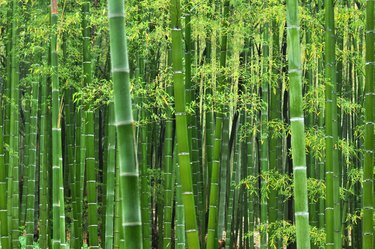
Bamboo refers to some 1,200 species of woody perennial grasses, some of which proliferate quickly and have a tendency to become invasive. Bamboo herbicides are often needed to control this weed, which competes with other plants for space and nutrients. Bamboo control does not happen overnight, however. In fact, it can take years and requires heavy doses of persistence and patience.
Clumping vs. Running Bamboo
Video of the Day
There are two kinds of bamboo: clumping and running. Clumping bamboo spreads just a few inches a year and can be easily removed by simply digging up the plants. Running bamboo, on the other hand, spreads very aggressively via underground rhizomes. The rhizomes of running bamboo can spread 100 or more from the mother plant, according to the Clemson University Extension. If even a small part of a running bamboo rhizome is left in the soil, it can reestablish itself.
Video of the Day
Therefore, one way to prevent bamboo from becoming invasive is simply by planting only clumping bamboo. Which species you choose depends on the climate where you live. Examples of clumping bamboo include the hardy bamboo (Fargesia rufa), one of the more cold-resistant varieties, which reaches heights of approximately 10 feet. The Buddha belly bamboo (Bambusa ventricosa), which is also non-running, can be up to 55 feet tall. Unlike hardy bamboo, Buddha belly bamboo cannot tolerate frost.
Best Bamboo Herbicide

An herbicide is often necessary to eliminate bamboo that has become invasive. According to the Clemson University Extension, to control bamboo, you should reach for a product that has the chemical glyphosate as its active ingredient – at least 41 percent glyphosate.
For glyphosate to work best, you should mow the bamboo and allow it to grow to a height of approximately 3 feet. When new leaves have expanded, apply the herbicide. You will need to do this multiple times over several years to get bamboo under control. Note that glyphosate herbicides for sale have virtually no soil activity and must come into direct contact with the bamboo leaves in order to work properly.
You can also use a chemical called imazapyr to kill bamboo which may be more effective than glyphosate. However, the University of Florida Institute of Food and Agricultural Science warns that, unlike glyphosate, this herbicide does have a high level of soil activity. As a result, if the roots of other plants, like trees and shrubs, extend into the treated soil, they may also be killed.
Other Control Methods

To control invasive running bamboo, you will need to combine herbicides with other strategies. Because bamboo is a grass, mowing it often and aggressively, as you would a lawn, can also help eliminate it. Mowing usually takes two or three years to have an effect on bamboo.
The roots of bamboo are shallow and usually do not extend any further than a foot into the soil. Therefore, surrounding the bamboo with barriers made of concrete or metal barriers to a depth of 18 inches can be effective at preventing bamboo from spreading. For containment to work, however, you will need to check the barriers often for any rhizomes that have managed to escape.